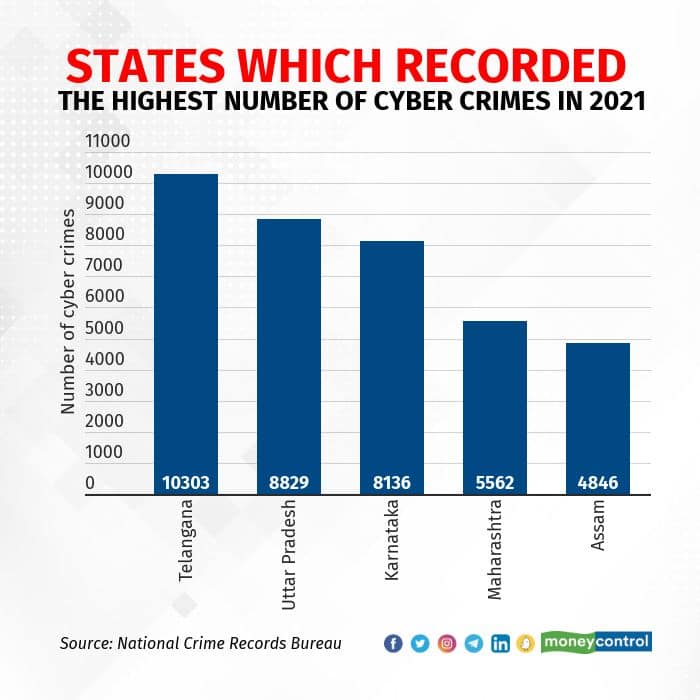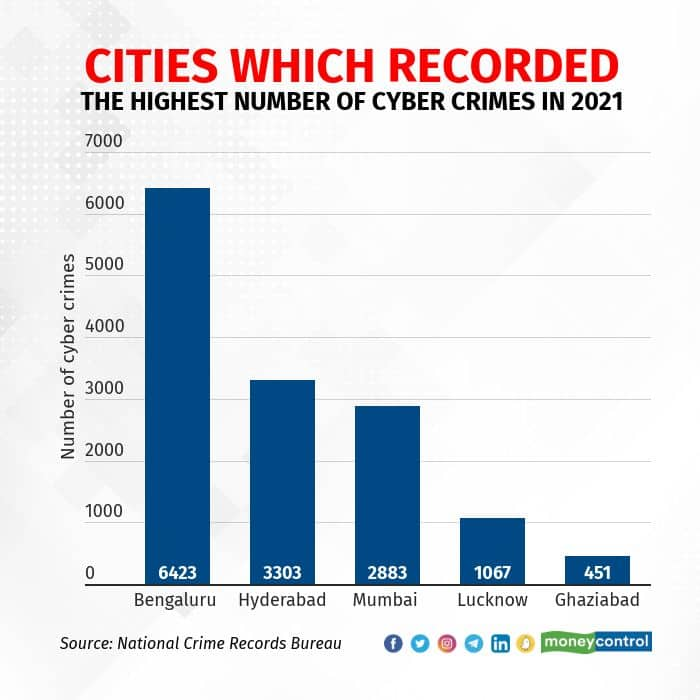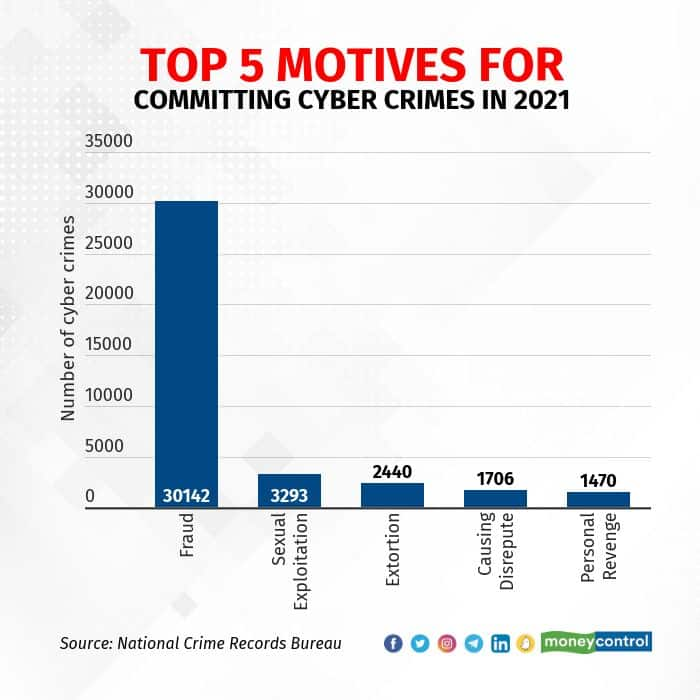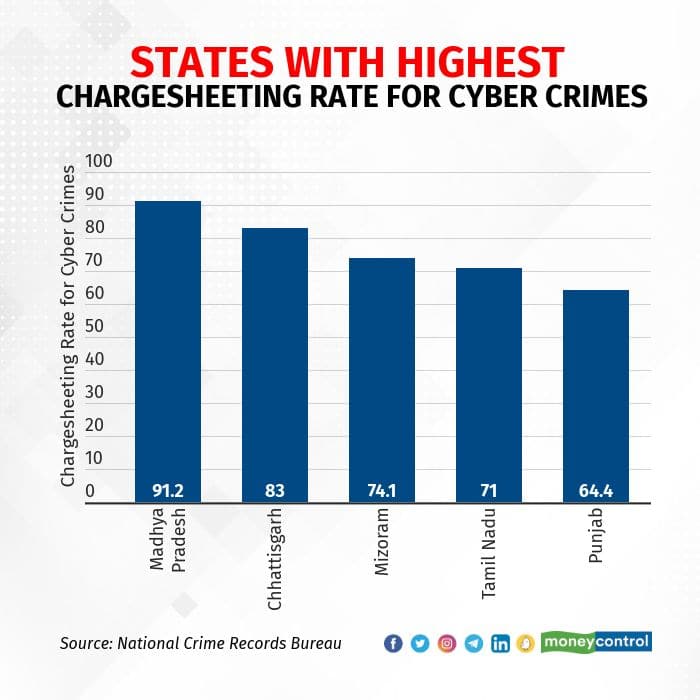



India reported 52,974 incidents of cyber crimes in 2021, an increase of nearly six percent from the year before. Telangana topped the chart among states, accounting for more than 19 percent, National Crime Records Bureau (NCRB) data shows.
The state reported 10,303 cases in 2021, an increase of 105 percent from the year before. The next two states in the list, Uttar Pradesh and Karnataka, however, saw the number decrease by 20 percent and 24 percent, respectively.
“We have been raising awareness among the people on cyber crimes, so more of them have been coming forward to report such cases,” said KVM Prasad, Assistant Commissioner of Police (Cyber Crime), Hyderabad.
“Although there has been a slight increase in cyber crimes, the major reason for the hike seen in NCRB data is because more people are reporting such crimes,” he added.

Uttar Pradesh recorded 8,829 cases in 2021, down from 11,097 in 2020. Meanwhile, Karnataka’s number of cases went down from 10,741 in 2020 to 8,136 in 2021.
Jurisdictional issues a major hurdle“Jurisdictional issues have been a major hindrance in cyber crime cases. Most cases reported in Telangana are being committed by people in other states like West Bengal, Bihar and UP. There is no mechanism to control them locally. And it is not so easy to go there and apprehend them,” said Prasad.
Such issues can make it difficult to connect a cyber crime to the criminal, experts say. “Often, incriminating electronic logs will have to be obtained from the servers of service providers outside India. When these service providers don’t provide the information, the case becomes harder to prove,” said Pavan Duggal, a cyber law expert and a practising advocate at the Supreme Court.
Among cities, India’s IT capital Bengaluru registered the most number of cyber crimes. However, the city has seen a decline in the number of reported cases in the last three years. Bengaluru recorded 6,423 cyber crime cases in 2021, down from 8,892 in 2020 and 10,555 in 2019.

Hyderabad, which came second in the list, saw the number jumping from 2,553 in 2020 to 3,303 in 2021.
Meanwhile, Mumbai, the next city in the chart, saw the number of cases increasing to 2,833 in 2021, after seeing a decline in the year before. Mumbai had recorded 2,433 such cases in 2020 and 2,527 in 2019.

As many as 32,230 cases, accounting for nearly 61 of the total cyber crime cases were done with the motive of committing fraud. Meanwhile, sexual exploitation, which was the second-most common motive, accounted for 8.6 percent (4,555 cases) followed by extortion, accounting for 5.4 percent (2,883 cases).

India recorded 10,730 cyber crimes against women in 2021. Out of this, most number of cases were registered for cyber pornography or for publishing obscene sexual materials. As many as 1,896 such cases were recorded in 2021. Karnataka recorded the highest number of cyber crimes against women, with 2,243 cases.
The police pendency percentage in cyber crime cases improved in 2021. While 71.3 percent of the total cases investigated are pending at the end of 2020, this figure came down to 56.4 percent in 2021.
‘Cyber crime conviction ratio still poor’“I do not really think this means that the police have become better equipped in dealing with cyber crimes. The cyber crime conviction ratio in the country remains poor. The reality in India is that there is a large under-counting of cyber crimes. We are seeing the ‘Jamtara’ model of cyber criminals mushrooming all over the country,” said Duggal.
Jamtara, a district in Jharkhand, is nick-named as the phishing capital of India as it is the centre point of numerous incidents of phishing across the country.
The charge-sheeting rate, which is described by the NCRB as a ‘better indicator of police performance’, has declined from 47.5 in 2020 to 33.8 in 2021 for cyber crimes.

Despite a slight decline from the previous year, court pendency percentage remained high in the country in 2021. As much as 81.4 percent of the total cases that were in trial in 2021 remained pending at the end of the year, down from 85.4 percent in 2020.
‘Lack of urgency seen in cyber cases’“The high pendency in cyber crime cases is invariably connected to a lack of appropriate production of incriminating electronic evidence in the courts of law. Moreover, a lack of urgency about such cases invariably leads to delay in courts. And the longer the trial goes, the more difficult it becomes for the prosecution to prove electronic evidences in courts” said Duggal.
Even among cyber crime cases that completed trial, the conviction rate stood at just 42.5. Out of the 1,155 cases that completed trial in 2021, only 491 ended in a conviction. Meanwhile, 591 cases, which is more than half of the total, ended in an acquittal and another 87 cases got discharged.
Discover the latest Business News, Sensex, and Nifty updates. Obtain Personal Finance insights, tax queries, and expert opinions on Moneycontrol or download the Moneycontrol App to stay updated!
Find the best of Al News in one place, specially curated for you every weekend.
Stay on top of the latest tech trends and biggest startup news.